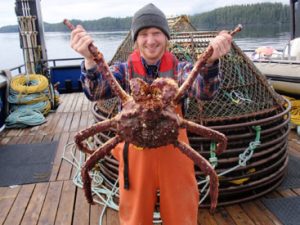King Crab Fishery in Southeast Alaska Approved
 In a significant policy shift, the Alaska Board of Fisheries has approved a proposal to permit a limited commercial harvest of red king crabs in Southeast Alaska. This decision, approved during the board’s Southeast and Yakutat Finfish and Shellfish meeting in Ketchikan from January 28 to February 9, 2025, changes previous regulations that required an estimated biomass of legal male red king crabs to exceed 200,000 pounds before opening a commercial fishery. This threshold had resulted in only three commercial red king crab seasons in the region over the past two decades.
In a significant policy shift, the Alaska Board of Fisheries has approved a proposal to permit a limited commercial harvest of red king crabs in Southeast Alaska. This decision, approved during the board’s Southeast and Yakutat Finfish and Shellfish meeting in Ketchikan from January 28 to February 9, 2025, changes previous regulations that required an estimated biomass of legal male red king crabs to exceed 200,000 pounds before opening a commercial fishery. This threshold had resulted in only three commercial red king crab seasons in the region over the past two decades.
The Alaska Department of Fish and Game (ADF&G) and commercial fishers agreed that the 200,000-pound requirement was based on outdated market conditions, which suggested that processors needed this volume to operate profitably. Nels Evens, Executive Director of the Petersburg Vessel Owner’s Association, emphasized that this threshold was not biologically necessary but was established due to past market demands.
The newly approved proposal allows regulators to open a small-scale commercial fishery even when the biomass is below the previous threshold. This change will provide economic opportunities for local crabbers while maintaining sustainable management of the red king crab population. Specific details regarding harvest limits and management will be determined by ADF&G as well as stakeholders.
This policy change reflects a trend in fisheries management, where economic considerations are balanced with conservation efforts. By enabling a limited harvest, the board hopes to support the local fishing industry without compromising the long-term health of the crab population. The decision has been met with cautious optimism from the fishing community, which views it as a step toward more flexible and responsive management practices.
The implementation of this limited fishery will require close monitoring to ensure that it supports conservation efforts. Management strategies that remain flexible with ongoing scientific reviews will be necessary to respond to any changes in the crab population. The collaboration between regulators, scientists, and the fishing industry will be crucial as everyone works toward a balance between economic stability and ecological sustainability.
 Maritime Injury Law Blog
Maritime Injury Law Blog

